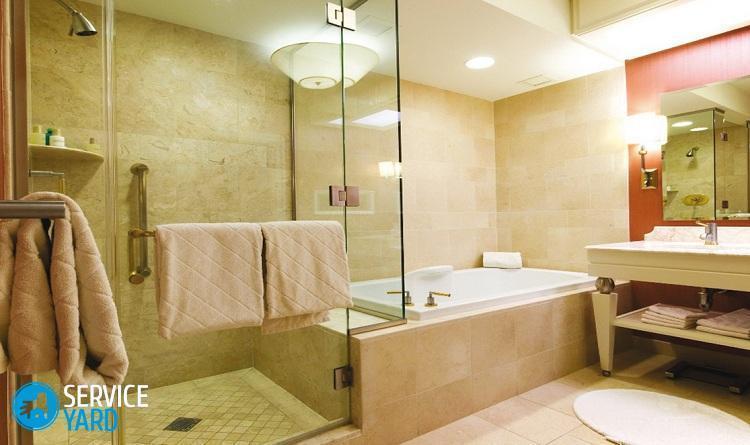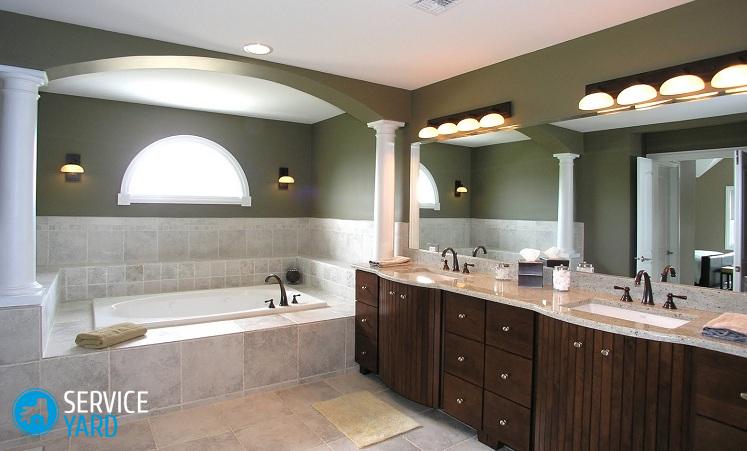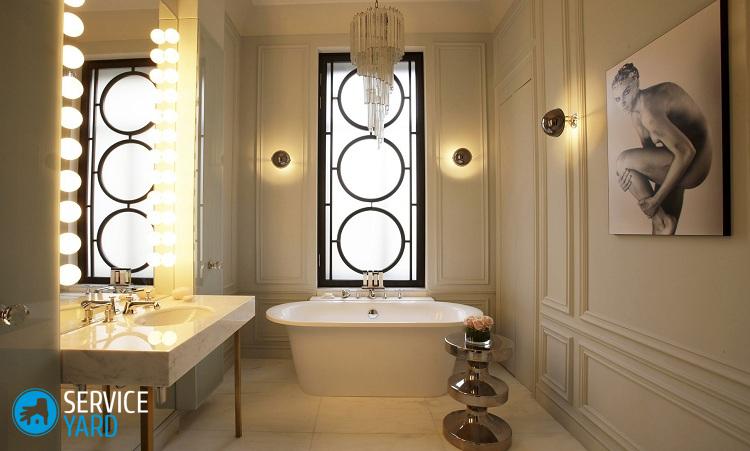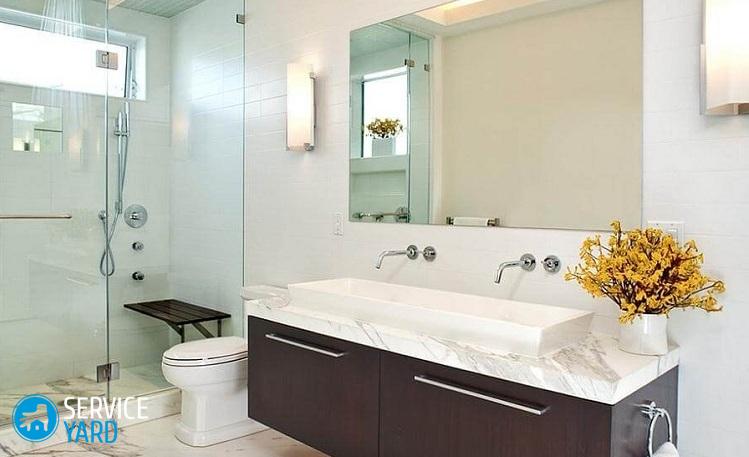Light in the bathroom
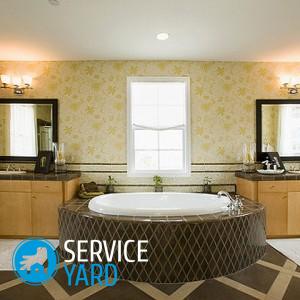
Lamps are capable of doing real miracles. They increase the height of the ceilings, change the geometry of the room, highlight interesting elements and hide unnecessary ones. In short, the role of lighting is difficult to overestimate. Especially carefully you need to approach the selection of plafonds and sconces when it comes to the design of a small space - for example, a bathroom. Light in the bathroom - what are its features? You will learn about this from the article.
to contents ↑Bathroom Features
Before you place the fixtures in the bathroom, you will need to develop a project, and for a start - to understand what your bathroom is and what are the features of this room:
- humidity is almost always in the bathroom;
- in this room temperature differences are possible;
- as a rule, the space is not very large;
- Lighting devices are the main decoration.
High humidity
Many factors influence the location of fixtures in a bathroom, and humidity is one of the main factors. The fact is that water perfectly conducts electric current. Clumsily laid wiring, as well as improper selection of fixtures and lamps, can lead to tragedy. Safety is the main thing to pay attention to.
Hence the two most important requirements:
- wiring must be hidden;
- All electrical appliances must have a high degree of moisture protection.
Temperature differences
If you are thinking about how to make lighting in the bathroom, pay attention to temperature differences. Of course, they are not as sharp as in the kitchen, but still tangible, especially where the owners like to take hot baths. It is better to choose lamps that are not particularly hot.
Resize
Lighting in a bathroom is greatly influenced by its size. In old houses, as a rule, overhead lighting was used - one ceiling was placed at the top. It was quite convenient, but not very beautiful, which was especially complained by those who prefer individual solutions. The uniformity was explained simply - there were very few luminaires that met safety requirements, so there wasn’t much to choose.
Now the situation has changed a lot. Therefore, to be limited to a single round shade there is absolutely no need. If you want to visually expand your bathroom, you can safely choose one of the following options:
- combination of top and side lights;
- small bright lamps in the corners;
- spot lighting with LEDs or LED strips.
Main decoration
There are not many opportunities to turn a bathroom from a purely utilitarian room into a cozy and beautiful, especially in high-rise buildings. Original plumbing, a panel of tiles, a beautiful mirror - that, perhaps, is all. Therefore, special attention should be paid to lamps, because the impression of the objects in the bathroom will depend on how the light falls. So the bathroom lighting design simply cannot be ignored.
All or parts?
Bathroom lighting can be:
- complete;
- partial.
As the name implies, in one case all the lights are turned on, in the other - only a few. For living rooms, this option has long been common, but in bathrooms it is not used as often. However, for large bathrooms, especially combined, it is very convenient, because it makes it possible:
- save energy;
- zoning the room.
Important! This is especially true if the room ceilings are at different levels. If you have a ceiling and sconce, you can arrange it so that they can be turned on both together and separately.
Those who prefer LEDs may find it interesting to use several options and turn them on autonomously:
central points;
- along the perimeter of the ceiling;
- mirror illumination;
- angular.
Full coverage is not necessary so often. It is required at the time of cleaning. But is it really necessary when you take a bath or shower? You can make morning and evening light, since the day of any modern person begins and ends in this room:
- Morning light is bright and invigorating as you need to quickly wake up and pack up.
- The evening light is muffled and relaxing.
Mirror Illumination
This is a very important point! When you make the light in the bathroom with your own hands, keep in mind that the mirror is not only an ornament, but also part of the work area - it is shaved in front of it, put on cosmetics, etc. Therefore, several requirements must be taken into account:
- lighting should emphasize the beauty of this subject;
- what is reflected in the mirror surface should be clearly visible, that is, the light must be made even and bright enough, but not dazzling.
So what is the best way to highlight a mirror? Several options are possible:
- one lamp in the center;
- two sconces on the sides;
- LED strip around the perimeter.
to contents ↑Important! Pay particular attention to models where the angle of inclination can be adjusted.
Make a project
The light in the bathroom with your own hands, like everything else, begins with the project. First you need to imagine what exactly you want. You can make the most primitive sketch - draw a view of your bathroom, for example, from the front door, arrange what will be there in the room, and think about how it should be illuminated.
But what looks beautiful and simple in the human imagination may in fact turn out to be completely different. Therefore, it is very useful to use special computer design programs, which are now quite a lot. With their help, you can not only correctly place everything you need in the bathroom, but also choose the optimal lighting fixtures for this room. And some online designers even allow you to immediately order them through online stores.
to contents ↑Important! Similar programs work in much the same way as strategy games - there is a special panel where you select details from a rather large list. By the way, you can make a sketch in 3D - and see what you have in mind, not only in your own imagination, but also in volume.
Lighting levels
When thinking about how to make light in a bathroom, consider that there should be three main lighting levels:
- top;
- working;
- lower.
Upper light
This is the same ceiling lamp, so bored with those who grew up in old houses. However, to this day for small rooms with high humidity, this is one of the best options. Plafonds are of two types:
- outboard;
- pills.
Hanging in bathrooms are used relatively rarely. When deciding to install one, pay attention to the quality of the bulbs - that is, to their level of moisture protection. A tablet is the most common option specifically for bathrooms, since it is screwed tight enough and moisture practically does not get inside.
As the top lighting in the bathroom, you can also use LED spotlights, which have a lot of advantages:
- they can be arranged as you like;
- they do not heat up at all:
- LEDs are completely insensitive to moisture, the main thing is that water does not get on the contacts.
Important! Plafonds are also suitable for large bathrooms, but it is better if there are several.
Work light
Work lights are luminaires located in places where some kind of activity takes place.Such a zone is always a mirror, but there can also be a bathtub, and a wash basin, and a shower cabin. You should be able to illuminate them well - or at least make an additional highlight that turns on when it's especially needed.
Lower lighting
It’s hard to arrange it in small bathrooms, and it’s not necessary. This is a feature of spacious rooms. Lighting devices are located at a distance of half a meter from the floor, and more often even lower, somewhere at the level of 40 cm.
to contents ↑Important! Such lighting is a purely decorative element. For example, you can visually create steps in a bathtub, pedestal, or something else of the same kind. For him, it is best to use multi-colored LED strips.
Talk about styles
Thinking about what kind of light to make in the bathroom, consider a few more features. Lighting devices must comply with the style of the room:
- If the bathroom is small, then the most popular stylistic solutions are Minimalism, Retro or Classic.
- For large rooms, Provence, Baroque, and the antique style, and much more.
Despite the fact that the choice of fixtures in stores is quite large, the color gamut of appliances that are used in bathrooms is generally limited. If you are hanging the ceiling, most likely it will be closed, from some light plastic or glass - transparent or opaque:
- For lovers of minimalism and high-tech, models of lamps in chrome-plated cases will be indispensable. Lamps made of plastic, decorated with sweeping, are also suitable - with clear shapes and a small amount of detail.
- Those who prefer Retro need the most ordinary pill lamp.
- Fans of Provence can afford a small chandelier and a couple of original sconces in the form of candelabra.
- Ethno lovers generally need to disguise the lamp so that it is not clear where the light is coming from - and only then the LEDs are simply irreplaceable.
In general, the design of a bathroom with LED lighting can be extremely diverse.
to contents ↑Dimensions
When arranging lighting in the bathroom with your own hands, it is very important to understand what size fixtures you need. This will greatly facilitate the choice. The dimensions of the shades and sconces are entirely dependent on the height of your ceilings and the size of the room. Chandeliers and low hanging lights are not recommended, but LED strips and slots can be hung anywhere.
to contents ↑Power
If we talk about the level of illumination of your bathroom, then it should be such as not to irritate and not to blind. It depends on the brightness of the light flux. It is measured by lumens. Different lamps give different luminous flux. The calculation for sanitary rooms is quite simple - a luminous flux of 200 lumens should fall per square meter of area.
In the bathrooms, different types of lamps are used:
- incandescent;
- luminescent;
- halogen;
- LED light.
They give different brightness of the stream. For example:
- with a conventional incandescent lamp of 25 W, it is 200 lm;
- at a luminescent power of 40 W, it will be ten times more;
- A 70-watt halogen gives a little more than a thousand lumens;
- LEDs are real champions, a lamp with a power of 30 to 80 W will give a luminous flux of 6,000 lumens.
Important! The choice of brightness very much depends on the color scheme of your bathroom. If the walls and ceiling are light, you can take the minimum power lamps, and if dark - you need the maximum brightness of the light flux.
About the advantages and disadvantages
Before you arrange lighting in the bathroom with your own hands, think about which lamps will be in your bathroom. Each species has its pros and cons:
- Incandescent lamps are cheap, but short-lived, their luminous flux is weak, they quickly burn out, and besides, they are not recommended for use in plastic fixtures.
- Halogen - they last a long time, they have good light output, but quite often a step-down transformer is needed.
- Fluorescent lamps give almost natural light, work for a long time, but they sometimes make noise, and in addition, their power does not exceed 150 watts.
- LED - and serve for a long time, and do not heat up, and the power can be any, but even such perfection has drawbacks - the high price and the need for a stable working power supply.
Mount wiring
Before arranging lighting in the bathroom, make a plan:
- Determine the number of fixtures.
- Identify their locations.
- Decide which wire section you need - the stable operation of the system depends on this, as well as security.
We calculate the cross-section of the wire
The cross section is calculated as follows:
- Add up the power of all the lamps that will be used in the bathroom.
- Divide the result by 220.
- You will get a load on the cable - it is expressed in amperes.
For each square millimeter of the cross-section of the wire, there should be no more than 4 Amperes per square millimeter for copper wire and not more than 3 for aluminum. For example, if you get a total current of 6 A, the diameter of the cross section of the aluminum wire should be 2 square meters. m
Important! Please also note that when installing the wiring, you can not use wires of different materials - they can form galvanic corrosion pairs. This will interrupt the contacts between the conductors. In the bathroom, do not use electrical tape - it lags behind when water gets in. A wire of a smaller cross section cannot be used, as this can cause burnout and fire.
How to make wiring?
Since the humidity in the bathroom is high, the wiring must be hidden:
- in the wall;
- in decoration.
You need to lay it right right away, otherwise you will have to hollow the wall again or change the finish, and this is an additional expense of money and time. You need to use a cable laid in the corrugation:
- Drill the wall and ceiling to the places where the fixtures will be mounted.
- Install the fixing clips.
- Lay the wires.
- Fix them with alabaster or gypsum mortar.
- Connect the system to the junction box.
- Check for short circuits.
- Close up the strobes.
We put a lamp
Is the wiring ready? Well, it's time to mount the lights. If you have three levels of lighting in your bathroom, start from the top, that is, the installation of ceiling fixtures. In this case, several important points must be taken into account:
- With suspended ceilings or those made of drywall, wiring must be done before installing panels or paintings - in this case, you do not need to ditch anything.
- The ends of the wires must be brought out 20 cm to the places where the lamps will be.
to contents ↑Important! It doesn’t matter in what order you will be drilling drywall - the holes can be made both before and after mounting the sheets on the ceiling, but you need to very accurately determine the attachment points of the fixtures - they should not be on the profile.
LED strip
It is not difficult to fix them, but this type of fixtures has its own characteristics:
- Thoroughly clean the ceiling or wall where you intend to mount them.
- Degrease it with solvent or mineral spirits.
- Remove the protective film from the tape.
- Connect the LEDs to the adapter - pay attention to the fact that the wires must go into the slots intended for them.
- Lay it down, pressing lightly (but not too hard).
Stretch ceiling
Now stretch ceilings are a very fashionable type of finish. But when organizing lighting in the bathroom on such surfaces, there are some nuances:
- Mount the lamp posts on the main ceiling.
- Make holes in the stretch ceiling.
- Insert heat insulating rings and yokes that will prevent tearing.
to contents ↑Important! For suspended ceilings, appliances with surface-mounted fixtures are more suitable than others. As for lamps, the power of incandescent lamps should not exceed 40 watts, and if you use halogen - 35 watts. But any LEDs are suitable, they will not cause any harm to the coating.
Stock footage
Lighting to create a unique interior in your bathroom. An ordinary sanitary room will turn into something intriguing and fabulous, and there is nothing complicated about it - the range of lighting fixtures and lamps in stores is so wide that both the supporter of minimalism and the ardent admirer of classical styles can easily find anything suitable.
- How to choose a vacuum cleaner taking into account the characteristics of the house and coatings?
- What to look for when choosing a water delivery
- How to quickly create comfort at home - tips for housewives
- How to choose the perfect TV - useful tips
- What to look for when choosing blinds
- What should be running shoes?
- What useful things can you buy in a hardware store
- Iphone 11 pro max review
- Than iPhone is better than Android smartphones



